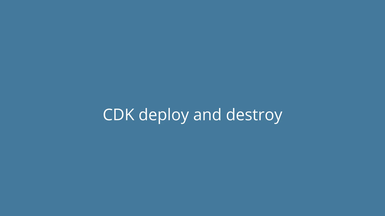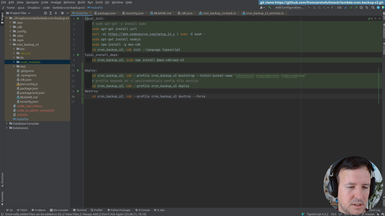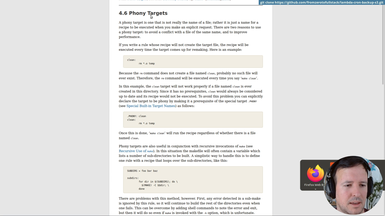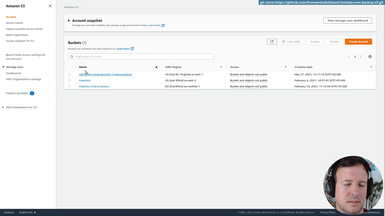Lambda function scheduled to perform backups of another server on s3
Ep.4 - CDK deploy and destroy
26 minutes
We will deploy our resources with cdk deploy. Once we are done we will use cdk destroy to remove the resources.
• Updating our Makefile to document the changes.
• Confirm the s3 bucket is created.
• Deal with common pitfalls when running cdk destroy — like s3 resoruces not being removed.
• Install autodelete bucket and missing aws dependencies.
• Makefile .PHONY targets.
• Permissions.
We will allocate and deallocate aws resources using cdk deploy and cdk destroy, and deal with some common problems we can run into.
Notes
• Source code in Githubhttps://github.com/fromzerotofullstack/lambda-cron-backup-s3/tree/
• Auto-delete-bucket library
@mobileposse/auto-delete-bucket
• Makefile phony targets
https://www.gnu.org/software/make/manual/html_node/Phony-Targets.html
• CDK cli guide (includes --require-approval)
https://docs.aws.amazon.com/cdk/latest/guide/cli.html
Transcript
okay so we have defined the resource that we want this
s3 bucket and now we're ready to deploy it so what
else is there to take into account so um normally the
deploy command would be something like this i'm gonna add it to the make file
so we run it from the folder of the rest of the command comments we could just
see the manually into it um and then we're gonna run like cdk
and then yeah let me explain this basically it
would be something like this deploy it right so um
it's cdk deploy right so why this profile
so you don't need this but basically it could be like this cdk deployed
uh and but and this will create all the resources we create
from our code the cloud formation resources and then
uh interpret that and create for real the resources
also careful with this because this could have real costs right
um so far it's going to be an empty bucket so the costs
will be zero or very minimal but what's with the profile so this
profile is the the user that the cdk is going to use to
get the credentials so basically you will have a credentials
file um like on on on your home directory like on
aw yeah so in this [Music]
yeah so basically in this file credentials which i cannot show you for
obvious reasons but basically let me open it in a new
let me just check it in a in a hidden window so i can
yeah so basically this has a structure like this
that's the second how can i show you this let me just open
another folder for a second yeah so basically this has a structure
so this looks like it's like a config file right so it's
like my user and then this like aws access
piv equals and a very long string and the same thing with like uh
secret secret access key and another long
string and then this is for my user but in our
case we have one that looks like this from backup
s3 and this is why the profile you pass will be
this one right so if you have my user you can choose here to pass my user
maybe you have just a default one there's also
one at the end called default all right so if you don't pass anything
it will be the default one and this allows you to have different
credentials for different things which is a good idea
not to have like a super credential doing doing everything
um yeah so that's all with this so in my case i have a profile called
chrome backup s3 just for this project right
so that's why i'm passing it i'm gonna leave this
the if you hear the comment [Music]
okay um and this should be enough but there's
one more thing to keep into account and we're ready to deploy um the thing
is there is basically if we go to lambda
here you can see here some of my
um sorry not lambda but s3 you can see here some of my buckets these are for
other projects but basically this one that you see here
cdk tool stick toolkit and this is basically the
boilerplate that amazon web services needs so they
need like a packet with some basic assets
and this is what the amazon uses right so um
because of this we're gonna need this basically for this project for lambda
for s3 so this is ways that we just added so
you can just add basically we're gonna add
here the same but bootstrap with the chrome backup s3 because mine
already exists i can already add the name
sometimes it's a bit buggy so let's say this
in this you can run several times and it's not a problem
you will just say it already exists let me keep going
but there's a chance that if you delete it if you read it sometimes
it loses a bit track of if it exists or not
and then you might get an error saying this specific
name doesn't exist in that case you can add
these right otherwise it should be enough
with this part so you just want to run basically a cdk bootstrap
so the cdk creates the minimum thing it needs to run the cdk
and then cdk deploy in my case i have i have it already
so because of that i'm going to put here the same name that we have
yeah it ends in osg osg but it should be the same for you so
basically let's deploy this and we should see an s3 bucket created
right an s3 packet with this name chrome backup s3
let's run it i'm just gonna run make deploy and we'll run all of this
okay [Music]
and let's see it's running the bootstrap first
uh okay and we have an error with the account access
well so the problem was that we didn't have this file
right um because i'm here in a restricted environment
um like using docker for this tutorial but basically i just created it and put
my credentials here and now it should work so we just do
make deploy okay so the credentials went through
it's about traveling the environment as you see here if the environment already
exists it will say this no changes
and now it's creating the cloud formation change set so from our code
we'll generate cloud formation and that will be created right so this
is looking good and we're gonna see how this will create
in the ui also the the packet so our idea is that
using the same process we're going to create s3 packets but also
lambdas basically anything we need from amazon web services infrastructure will
create this way we'll see there's some pitfalls to take
into account but basically it worked right it says
everything went fine this check is the confirmation
and that's it so we can go back to the ui
and then we should see here our packet i'm reloading
and here's our bucket right it's just empty
but uh but this is our bucket so this is looking good
um now um there is okay let's try so we saw there
is like a a deploy a command right there's also
a destroy command so the destroy command just removes
all the resources that we that we allocated
so let's try this because this is a common problem
and we want to deal with it as soon as possible so basically
is the same but it just says destroy right
i just created this for convenience to just do make destroy but basically is
this the same with the profile if we want to
use one and then there's also an option that is like force basically
it asks for confirmation so force always says yes basically
so let's run make destroy now or cdk destroy and see what happens
so we have the s3 bucket here and what we want what this should do is
remove the bucket right so let's try and make this through
and now it's running because of the force option it's not even gonna ask for
confirmation okay it says destroy it right this stack
was destroyed let's see if that's true so we go here to the ui
and surprise this bucket is still there so um this is a common problem with ss3
packets that they're not deleted basically so we need
to come here and delete the bucket
um also it's quite a manual process because
this interface asks us for things like this which is a good thing you know
but if every time we want to delete resources we need to do this uh
i mean now we i had one bucket but imagine we have a hundred
no so we need to come here and manually do all of this so
it's uh it's not uh it's not how we want to do it
basically so um and the message here says that it has been destroyed right
which is it's not true so um we're gonna find a
solution for for this so what is the solution uh for
this bucket there's another bucket that we can use
from a third party that basically has the correct behavior
so um [Applause]
it's called uh [Music]
how to delete bucket so we can basically let me find that
let me show you the repository that basically is this
a little bugger exactly so this one yeah and it will be empty before it's
destroyed because that's another issue if you have
things inside the bucket you cannot remove it without
removing the things inside so basically quite complicated
but uh once once you add this basically we can copy this import
and basically this is a drop-in replacement right so super easy
so we decided here we need to install it soon also
but yeah basically this it will be auto delete bucket
and all the options inside are the same so
we can just remove this and here we'll use auto delete bucket
and just like that this will work so this is a pretty good library
so i'm very happy with it and um [Music]
yeah i just found it and it's it's really really useful
so um we need to install this first right so we're gonna add it
to our install commands let's go to make file
now we start seeing why why they make file i think it's a good idea
because we can have all this history right
of what we installed and what not and there's quite a lot of stuff so
then we can run this local install devs again
and we should be good to go also while we're at it here there's a make file
and there's some basically file has like an old history it's it's
assuming that we are creating files as a result of this
because this was used for compiling mostly
so basically there's this tiny thing called like phony targets you can find
more about it online but
but basically it's something we can use to make sure that there's no
extra mistakes so here you have some some stuff um this is what you would
have to google if you want to check more about it
um but i mean i mean you have all the resources here too
i just won't bore you with it but basically
you can you can basically here list the targets
where um you let's say normally a makefile will
generate a file and if the file has the same name as the target
then the target is considered executed so you couldn't execute again
right here we don't want anything like that so one thing we can do is just list
all the targets here in this special declaration it's phony
and the only thing this will do is that if for instance if we are running deploy
and there's a file named deploy normally it would not run it because you
could say the file already exists because of this historical accident
right um but we want it to run no matter what
so we don't care if there's a file with the same name
so we just add here all the all the targets now and then we make
sure that it's running every single time what we don't want is that by chance
there's a file called local init or destroy
and then we think we're running it and it's not really running so just as a
site there's this funny thing for make fast i'll just add it here
um and then we can uh it's not needed now but you know uh it
was time to add it at some point so i said it now
and then we can run the locally installed devs so
i'm just gonna run make local install depth
and they should install our new auto delete bucket and we're gonna try it
right now i think it's worth to know about this
library because it's really really useful and it can save you money if you
have a lot of resources and you think you deleted them but you did not delete
them like you will get charged for that that
storage even if it's only a bit but yeah you will so
okay major version we can update this later for now let's keep going so now we
have this installed we're gonna see exactly
this warning disappeared so that's good and now we should be able to do the same
thing as before but now the destroy method should work
right so let's uh let's see first we're gonna
deploy as always this bootstrap thing should do
nothing okay so there's some there's some kind
of mistake so here we must have done some mistake
how to delete bucket from mobile pose
okay so it looks like maybe it could be this ad here it should be
installed i think um here it is npm app
let's try it with this install and see if that works because it seems
like it's the dependencies right so we run local
install devs depths again
and we can see if it works okay it seems now installing new stuff
so let's see [Applause]
and then we try to deploy the bootstrap should be fine
no still we have an error require stack i think it provides some
dependencies of how to delete bucket itself right
so just okay so the error was here all the time right
so i need to read it um it says cannot find module
uh lambda so basically we are not using lambda yet in our
script but this uh [Music]
this auto delete bucket is using it right so we need to add it
for it because it will use lambda to to actually check that we are delete to
delete the packet afterwards right so we can just add it uh
[Music] let me just so basically this one
all right and then we can just add it to the
imports and install it and everything so um reside here and it's gonna be
our quote so we're single [Music]
so this is the lambda one and then we're gonna need to
add it also here to the make file right so here
it's aws and this should be enough now uh
this here there's a warning line and a squiggly line
um yeah so let's just run the install again
because we we added this right and now we have
these new dependencies so let's run the install
now this will install lambda and and the auto delete bucket depends on
lambda so the deploy now should work okay it's doing its thing the lambda was
installed we can see here and the squiggly line should be gone
yeah and then we can deploy let's see if this one worked
it should and they should create the s3 back
okay okay so we have all other dependencies right so now
let's add the cloud formation which also makes sense i'm not sure why
this library is not including all visas dependencies and they're just getting
installed and unless maybe i'm making some kind of
mistake uh yeah but basically aws
cloud formation i wonder if i i don't think i even need
to import this i just need to install it right
okay let's try all these dependencies um transformation
you cannot find module aws cdk cloud formation
okay let's add it uh [Music]
it's a bit strange maybe it's part of another model too anyway
and we're gonna add it so uh i'm not sure we need to import this but
it needs to be installed for sure so let's try to install it only
and then if it complains so this will be the same as before npm
install and cloud formation this time we're just
gonna run this one command and we try it again so we go into the
chrome backup run this command
okay and let's try the deploy again and see what new error
from the parent and see what new error we get
okay it seems like it's going through uh okay do you wish to deploy these changes
yes so now it's asking us right um we can also make this default right
to always say yes i think for the destroy i'm going to
leave it on the default to say yes but in this one no
but just so you know you could add uh maybe let's add it even to the
argument well let's say yes first and now
while it's going on i'll show you all the things
that we can do here um just a second so basically
deploy yeah so there's this option [Music]
uh it's called required approval never
um yeah i mean there's a lot of websites talking about the same thing
but basically approval exactly so this is the the
option so if you want we can add here to the
deploy like require i have it here somewhere
i require approval never so if you don't want this
confirmation which i recommend to leave it on
because this has real world consequences but if you don't want it you can just
add require approval never
so let me just add here the comment and then i'm gonna comment it out but
it's here for documentation okay so this could be the require
approval never right uh so so far it's running
let's see how it's going it's almost finished
and here it is it says it all went correctly
okay so let's see if it's true we can go here the management console in
s3 and we can see our bucket here also
empty because we only created the bucket itself
but it created so that's good um now until here is the same we had before
right so what's the difference the difference is that
when we run destroy this should remove the
the bucket now which would be something different from the default behavior
so let's do that let's run make destroy [Music]
destroy which will not ask for confirmation and now i
should say ideally that everything is okay and then
we should go and check that actually the packet has been deleted so let's see
it's running here's our bucket all right there's some auto bucket stuff here
going on and it says destroy it um so let's see in the ui
i reload the page and our packet is destroyed so that's uh
that's pretty cool so like this we can make sure that our
resources are created and destroyed correctly and we
can build on top of this so yeah this is how we can do it also
and i didn't basically i have to write permissions
here but let me copy here some permissions that you
might need so basically i'm going to add them here
in the documentation but basically to deploy you need certain
permissions i'm just going to copy them here
so some of these might apply to you right so if you use lambda
you will need some kind of land access if you
want to use the logs of cloud watch which we will use
if you want to use s3 you're gonna need s3 access
so you will need to configure this as an access so somewhere in amazon
web services you're gonna need to configure
um the permissions right so somewhere here like users maybe user
groups security groups wait a second
yeah exactly this iam right so here you will be able to so here in user
roles you can add like the the needed permissions right so
probably as roles better but um you can search there and you can add the
permissions that it asks you to add i would recommend having each of these
things in like a different role a different user and
things right it's a bit annoying to add all this uh
all these permissions but you don't want to be using your root user and then
losing it or you know it would be catastrophic
because it can cost a lot of money on amazon so
just that as an aside but um where we are now is we can deploy and we
can destroy resources defined with the cdk
so we're gonna take it from here and start adding here everything we need to
do a chrome right so we're gonna need some lambdas we
need to connect to some servers so the next steps are building up
on this
Clone the repository
git clone https://github.com/fromzerotofullstack/lambda-cron-backup-s3
Episodes
Ep.1 - Introduction: Lambda cron backup to s3
(4 minutes)
We explain how the project will be structured and what we are trying to accomplish: a cron process running on AWS Lambda to backup an external server.
• AWS Lambda
• AWS Cloudformation
• AWS CDK
• AWS S3

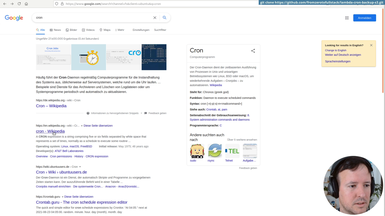
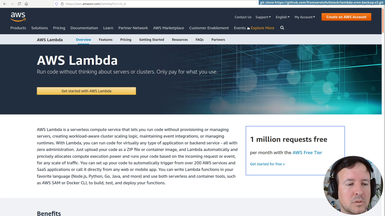
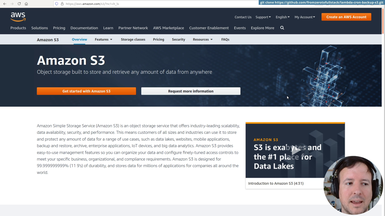
Ep.2 - Installing dependencies
(6 minutes)
We start installing the dependencies for the project.
• curl
• Nodejs and npm
• AWS CDK
We will start organizing the commands used to install dependencies on a Makefile
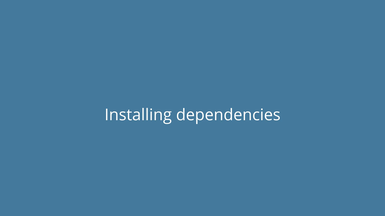
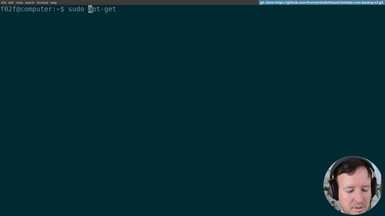
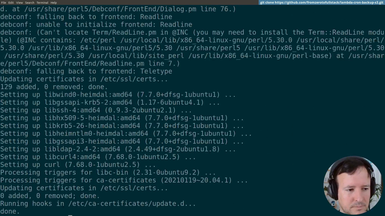
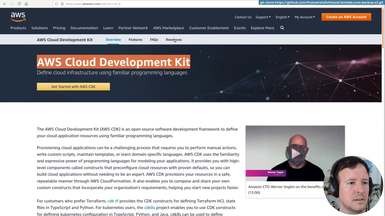
Ep.3 - CDK first steps
(15 minutes)
We will run cdk init to start a Typescript project.
• Updating our Makefile to document the setup commands
• Creating a folder with the stack, service, and dependencies
• Install missing aws and system dependencies as we need them
We start by defining a new s3 bucket we want to create.
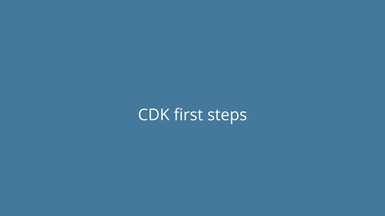
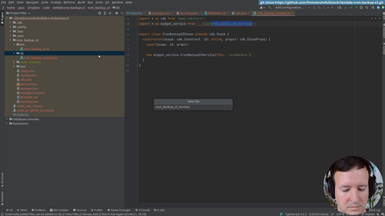

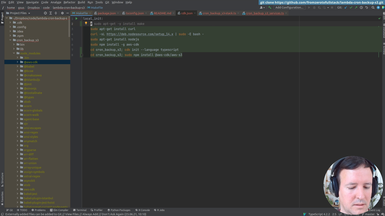
Ep.4 - CDK deploy and destroy
(26 minutes)
We will deploy our resources with cdk deploy. Once we are done we will use cdk destroy to remove the resources.
• Updating our Makefile to document the changes.
• Confirm the s3 bucket is created.
• Deal with common pitfalls when running cdk destroy — like s3 resoruces not being removed.
• Install autodelete bucket and missing aws dependencies.
• Makefile .PHONY targets.
• Permissions.
We will allocate and deallocate aws resources using cdk deploy and cdk destroy, and deal with some common problems we can run into.
